Returning to retail after an under-appreciated arrival in 1984, learn how the model made infamous by a rising rookie is more than just an Air Jordan origin story.
In the pantheon of sneaker hype, two archival Nike models eclipse almost all: 1982’s Air Force 1 and 1985’s original Air Jordan. From SNKRS sellouts to coveted collaborations, both iconic pairs took the brand’s basketball business to new heights.
With the arrival of Air Force 1, designer Bruce Kilgore brought the Swoosh’s tried and true Air technology to the hardwood, releasing a strapped and sloping design that was unlike anything on the market. Not only was the shoe technically advanced, but it had a perfectly premium look for any echelon of blacktop baller.
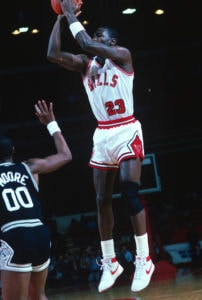
Three years later, the Beaverton brand struck gold again with the release of the Air Jordan in Spring 1985.
Worn by the eventual NBA Rookie of the Year, the concept of signing an African-American athlete endorser a team sport using the same Nike marketing machine usually reserved for white tennis stars was counter to the culture and controversial besides.
At that time, even NBA peers scoffed at Nike’s notion to market Michael Jordan in such singular fashion, and his handsome salary and inordinate athleticism only highlighted matters.
But by the end of 1985, Nike had made millions off Air Jordan alone, proving proof of concept — and absolutely inverting the industry.
Between the releases of the vanguard Air Force 1 and brash Air Jordan, the Beaverton brand produced several other Swoosh’d sneakers, but only one pair truly tells the tale of the bridge between both.
The Nike Air Ship.
Returning in retro life as an A Ma Maniere collaboration after two limited launches driven by Jordan Brand, the shoe that time forgot is having its moment as a sought-after lifestyle sneaker decades after its first drop.
To learn the origin of the mysterious model’s design and just why Michael Jordan wore hybrid pairs for his Chicago arrival, Boardroom sat down with a group of former Nike execs, known collectively as the 6453ers, to get the inside scoop on the sequel/prequel to basketball’s biggest breadwinners.
“The Air Ship was probably 39 years too early”
To know the history of the Nike Air Ship is to understand the pairs that preceded it.
In 1978, Nike introduced the Air Tailwind, the first running shoe to feature encapsulated air packets as a cushioning solution. Only in its infancy, the Beaverton-based brand was born on Oregon tracks and trails with most sales and fanfare coming from hardcore runners and casual joggers. At that time, Nike had crossed over to the court by way of tennis and basketball, with the latter led at the time by the likes of Converse and Adidas.
When it came to hoops in the early 1980s, Nike lacked the clout and the cachet. Though the brand’s Blazer was worn by George Gervin and World B. Free on the NBA court, the Chevron and the Stripes had the hardwood on lock thanks to relationships with college coaches and the pedigree of pros who grew up adoring their designs. In order for Nike to disrupt the category, they needed to get edgy and innovative.
By 1982, basketball’s Blazer and the Tailwind’s technology converged on the Nike Air Force 1: a hardwood hiking boot of a sneaker meant to change hoops. It was an industry-shifting shoe full of flavor and imperfections.
Brad Johnson (Former Head of Category at Nike Basketball): In 1979-80, 80 to 90% of our sales at that time were in running shoes. We were trying to translate the learning from runners to other sports. In ’82, Converse was the authentic basketball shoe and Nike was trying to become the authentic running company.
We were really trying to use innovation as a point of differentiation. We believed in Air, but there was skepticism from athletes who’ve been playing since they were kids in Pro-Keds or Converse with zero cushioning or ankle support. That’s what Exeter did in the Sports Research Lab to learn the impact put on a basketball player versus a runner.
Ron Hill (Oversaw Nike Product Merchandising in the ’80s & ’90s): I started in ’81 and was one of the few retail people. We had just introduced Air.
At that point in time, basketball was below tennis in total sales. Running was first and tennis kind of had a street appeal. We sold basketball shoes basically in the fall up until Christmas. We might add a color or two in the spring, but it was really all fall.
Brad Johnson: In 1982, I became the Product Line Manager for the basketball category. We’d launched the Air Force 1 — the original version with the mesh — and then we went to the all-leather version. At that time, Bill Bowerman’s halo over the brand was that everything was about weight and performance. From a weight standpoint, the Air Force 1 was a heavy basketball shoe and we wanted to solve for weight, flexibility, and breathability.
The big conundrum back then was making a shoe that didn’t overheat indoors for basketball but the reps would say we couldn’t sell mesh shoes for people that wanted sneakers to wear on the streets. There was always that tension. We always listened to the athletes and they were concerned about the stability of the Air Force 1; they wanted to be lower to the ground.
We briefed two shoes: the Air Ship to replace the Air Force 1 and the Air Train. The Air Ship was briefed to be the second Air basketball shoe.
Bruce Kilgore (Footwear Designer, Implemented Nike Air into the Air Force 1): I’m the designer of the Air Ship.
A designer named Doug Minor had an idea of doing an extruded sort of honeycomb cushioning system for a midsole. From an engineering perspective, it was a bit of a nightmare to work out, so I reached out to a professional engineer friend and asked him if there was some way we could create a cushioning system where we could control the heights and qualities of the system.
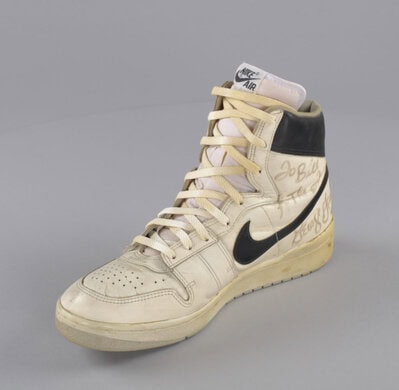
He told me there was good engineering information on buckling columns, so he wrote a computer program so we could engineer the loading, material properties, and spacing of the columns. That was pillar cushioning. With that, we could give a cushioning system that gave us similar qualities to the Air sole, but we could reduce the profile and reduce the weight with similar performance.
We encapsulated the Air sole in the heel which was inherently stiffer. The midsole had pillars that lined up with the flex grooves in the bottom. We took the center pressure idea from the Pegasus running shoe, which took out a lot of the weight and centered the heel on impact. It really helped the cushioning and had a good stabilizing effect for basketball.
In an attempt to elevate Air as part of the Nike Basketball category without sacrificing stability, Nike’s Sports Marketing Lab in Exeter, New Hampshire conducted study after study to explore just how the brand’s trademark tech could move swiftly from the track to the court.
Kirk Richardson (Nike’s AF1 Therapist/SMUs at Footlocker in the ’80s): The multiplier of ground impact force for a basketball player is probably 3x or 4x what a runner experiences, so it was not only measurable science-based targets but the evidence was informing us that we just had to dial this in.
We have to get the whole bill of materials to work together in such a way that the foot was stable, the product was stable, and it provided great traction.
Brad Johnson: The Air Ship was probably 39 years too early; it was a great product for 2022. We could go through every component and explain how we made it better than the Air Force 1.
The flex grooves Bruce designed in the outsole made the forefoot a lot more flexible to improve the ride. It gave a visual because people were nervous of Air being unstable.
Kirk Richardson: Yeah, there’s natural skepticism to new technology in any market, but guys like Bruce Kilgore, myself, and others were hearing that Air had significant performance benefits that we just needed time to explain. Nike is a company driven by deep consumer insights and technological decisions are driven by science.
We were spending about $7 million then — probably about $35 million by today’s standards — and we were getting continual bombardment from the lab saying, “Why the F are you not using this technology in all your shoes?!”
Dave Siddons (Nike Sales in the ’80s & ’90s): This shoe is a bit of an unknown. It was an interesting time, as Jordan was about to be launched.
“Stern said, ‘It doesn’t work like that. It’s $1,000, $5,000, then $10,000, then we’ll suspend him.’“
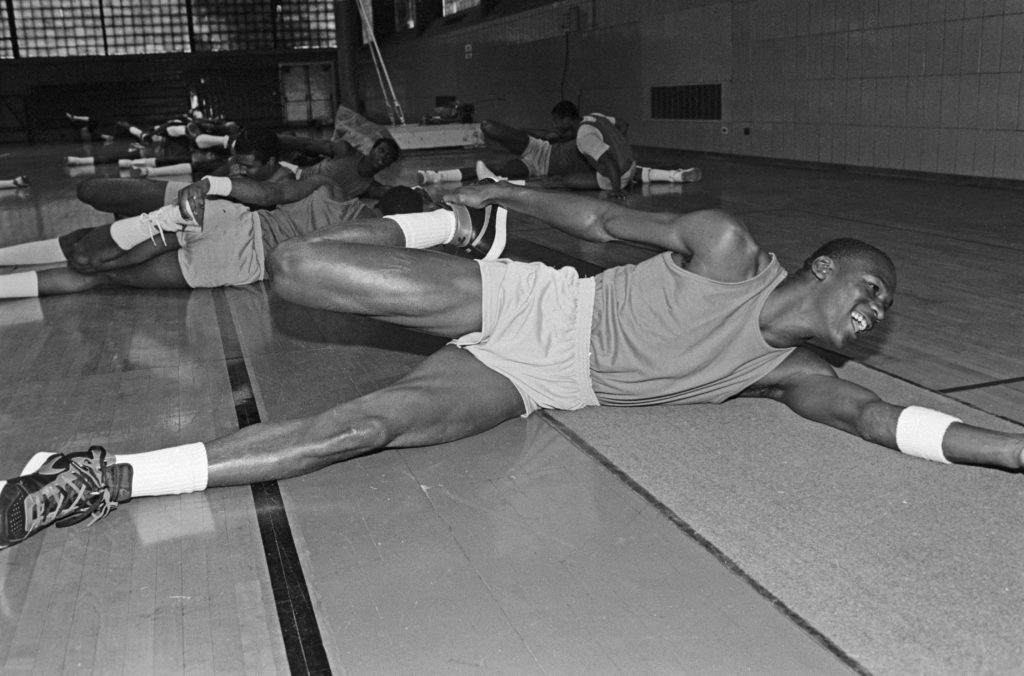
Brad Johnson: I was involved with the sports marketing guys at the time, and as I recall with the Air Jordan, we had signed Michael right after the ’84 Olympics. The season was starting in the fall and we needed some shoes for him; Peter Moore had designed the shoe and we decided he was going to be the first quasi-signature athlete. The Air Ship was releasing that fall and the shoe was pretty much done.
At that point in time, we were just being introduced to Michael. He had always played in Converse and had never worn a shoe with anything in the midsole. We were trying to convince him on Air and whether or not we should call it the “Air Jordan.” Everything was happening at hyper-speed because we signed him at the end of August and he was going to play in October!
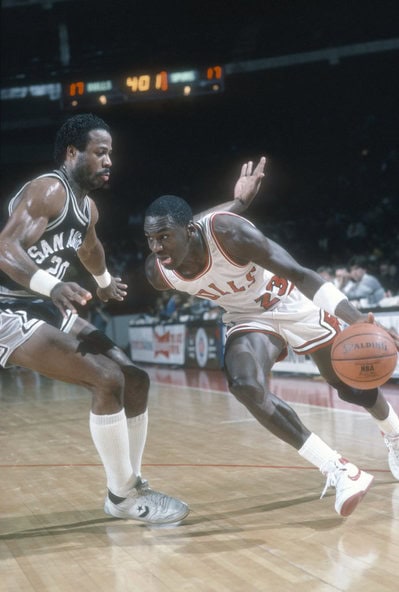
We were trying a lot of different things. Originally, we wanted to have him in the Air Ship because we didn’t think we could get a shoe to market. His promo shoes were made in the sample room and got to him as soon as possible.
Rob Strasser said, ‘Hey, he needs some shoes. What are you going to put him in?’ So, we were cobbling up shoes with whatever outsoles we had available with different combinations to allow him to try them because he’d never worn Nike shoes before.
He was the test athlete, which was fantastic because he signed this huge $500,000 contract and we had to get him in some shoes. We were literally calling Asia and saying, ‘What do you have in uppers? What do you have in outsoles?’ The Pro Circuits were being made in Korea, we were developing the product in Exeter, and trying to communicate in three different time zones, which was crazy.
That’s how we ended up with the same shoe in different combinations.
Tom Amedeo (InStyleShoes Owner/Lifelong Enthusiast): The Black/Red PE had a Pro Circuit bottom, whereas a week later, his Air Ship had an Air Jordan 1 bottom.
Brad Johnson: He never wore the Black/Red Air Ship in a [regular season] NBA game because that’s when [NBA Commissioner] David Stern called and said, ‘We’re fining him $1,000.’ Rob Strasser said, ‘Great, we’re going to send you a check for $82,000 because he’s going to wear them every game.’
Stern said, ‘It doesn’t work like that. It’s $1,000, $5,000, then $10,000, then we’ll suspend him.’
Ron Hill: The rule at the time was the team had to wear the same thing.
Brad Johnson: We’ve gotta figure out how to do this color thing and make it work. The NBA sent out a rule and an approval process where footwear companies had to submit our drawings and colors to show how the scheme represented the uniform. It had to be either a majority white or a majority team color.
Adhering to Stern’s rules and cobbling shoes in three time zones, the team at Nike presented Michael with a new Air Ship Player Exclusive made to the specifics of the star and the league. Dressed in white with red accents, this Air Ship PE was cut lower like a mid-top and featured the slimmed-down sole set to score his upcoming signature shoe.
Russ Bengtson (Author/Former SLAM & Complex Editor): I was a Jordan fan from the beginning, but because information was so few and far between, I don’t know if I even made the connection until later on.
The White/Red pair was like test mules. It was a lower cut with a lower profile sole.
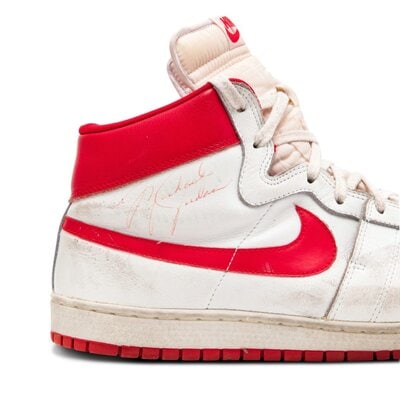
Brad Johnson: He didn’t like the collar heights being as high, he wanted a mid-cut type design. He was worried about the pressure on his Achilles tendon and wanted more flexibility.
When you talk about Jordan, we’d make him 18 pairs of shoes and he started signing them and giving them away. We thought 18 pairs would last him a whole season. For him, it lasted 18 games!
He changed that game because none of the other athletes were that popular. Strasser said, ‘Make him 72 pairs, 100 pairs, as many as he wants!’
Jordan wore the Air Ship because we wanted him to have a full-length cushioned shoe. I mean, the guy was jumping 40 inches in the air.
While plenty of modified Nike Air Ship sneakers made their way to Michael Jordan during the front half of his rookie debut, the inline iterations traveled a far different path.
“You bought them at Marshall’s?”
In 2022, storytelling, folklore, and hype around the Nike Air Ship are arguably at an all-time high, with pairs trading on StockX for hundreds and even thousands of dollars.
Worn by MJ in cobbled custom form for his early antics as a rookie in Chicago, the Air Ship has been positioned as an origin story for the Air Jordan 1. In many ways it was; however, in 1984 the market for basketball shoes was very different.
Jerry Alloco (Distribution at Nike in the ’80s & ’90s/’The Man in The Street’): I worked at Nike for 33 years, and during the time of the Air Ship, I was a humble rep at Metro Sports Sales based out of Long Island. Much like the rest of the sales guys, it was focused on team sports and if you had a team dealer, you probably booked a few pairs.
Brad Johnson: We took future sales on the Air Ship and they were so low that we weren’t going to build them. We had to fight tooth and nail just to get molds made.
Ron Hill: The good reps actually booked the Air Ship [laughs].
Russ Bengtson: My relationship with Air Ship was as a consumer. I got a pair at Marshall’s in what must’ve been ’85 for like $35. I grew up in the suburbs with malls and I don’t remember seeing them at Herman’s, Athlete’s Foot, or Korvette’s.

Ron Hill: You bought them at Marshall’s? That’s very telling of the sales team…
Jerry Alloco: It was positioned as a team shoe. How many team dealers did we have at that point?
Ron Hill: Team bank was the vehicle that went to the high school teams, so there wasn’t this need for a lot of footwear because running shoes dominated and then tennis shoes.
Basketball was a distant third and at that point, we didn’t know the magic of Air Force 1.
When we put it into the team bank we’d buy enough to cover the teams, so we’d book it to minimums.
Though an absolute improvement to the Air Force 1 where play was concerned, the Nike Air Ship did not see the same distribution or marketing push as its predecessor.
Because of this, most pairs were presented to pro players with Nike contracts or coaches signed to the Swoosh. The rest of the pairs simply slipped through the cracks.
Brad Johnson: We went to the colleges and just gave them shoes. When we went to the pros, they didn’t want to try it.
But if we got guys in the shoes? They loved it.
Tom Amedeo: Byron Scott, Steve Kerr, Len Bias, and Larry Nance…
Bruce Kilgore: The professional players were skeptical, but the wear-testing we were doing with college players? There was a lot of acceptance and good feedback from them.
Ron Hill: The other point is if you gave them to the college coach they’d say, ‘Hey, we’re gonna wear this.’ So, the Air Ship was the highest-priced shoe and it was a basketball shoe only.
“Almost the shoe time forgot”
From a consumer standpoint in 1984, the Nike Air Ship was a shoe sold into teams of the high school and college variety, occasionally seen on top NBA athletes.
In reality, it was the best basketball shoe Nike had made to that point.
Ron Hill: It’s what we had until we had Air Jordan shoes. Bruce and Brad set out to make a better basketball shoe, and it wasn’t intended for Michael at that time.
[Michael] never once asked back. He always knew something new was coming.
Russ Bengtson: Then it was a linear progression that athletes would wear a better or at least different shoe each year. The Air Ship was an evolution of the Air Force 1, and at the time it came out, it was the best Nike Air basketball shoe produced.
Brad Johnson: There was a lot of skepticism around Air Force 1. We were positioning it as more of a “big guy” type product, and as we did the Air Ship and the AirTrain, we thought maybe we could get the Ron Harpers and the Norm Nixons in them. But realistically, most of the guys at that time were pretty resistant of the full-length cushioning. We told them it would be good for them in the long term, but those guys weren’t thinking further ahead than the next season.
The Sports Research Lab in Exeter was highly focused on athlete insights; Beaverton was more focused on consumer insights. It was the blending of those two things, the art, and the science, which is what made Nike what it is today.
Bruce Kilgore: Before the Sports Research Lab, all the innovations were based on perception. It wasn’t until we had the lab that it was perceivable and measurable.
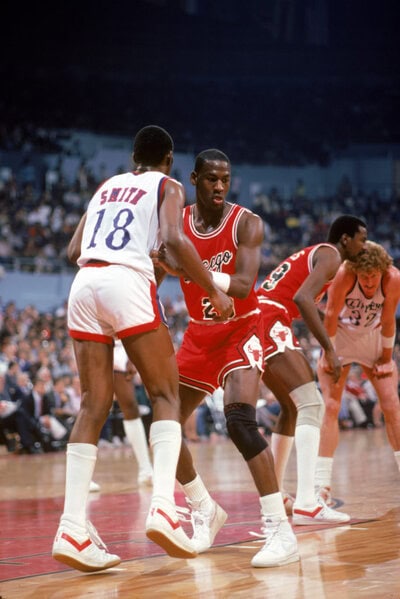
Russ Bengtson: The shoe is almost the shoe time forgot. It came out at that interesting time where you do the Air Force 1, and by the time Ship comes out, the Air Force 1 is hitting those cultural marketers.
Then, the Air Force 1 gets re-released, Adidas releases the Forum, which to me was their answer to the Air Force 1, and the Ship kind of gets skipped over.
It did things better than the Air Force 1 in some ways, but because of the cultural adoption and being sold as a team bank shoe people passed it by.
From a technical standpoint, it was an advancement from the Air Force 1.
The Air Train was really 40 years ahead of its time. You could probably trace a straight line from the Train to Hyperfuse and a lot of the Flyknit stuff. Flyknit allowed you to position synthetics as premium where you couldn’t in the ’80s; mesh was just seen as a cheaper option.
Ron Hill: The Train was a better player’s shoe, truthfully.
Russ Bengtson: The Air Ship being a Jordan shoe is such a small part of its history. [As a retro] I had no chance at getting the White/Red ones and zero chance at the Black/Red ones. I have the White/Navy and White/Natural OGs and I bought both of those on eBay 20 years ago.
The story of the Air Ship begins with its design, being designed as the successor to the Air Force 1 and to be Nike’s best basketball shoe. The Jordan part comes in because you signed this athlete for $500,000 and need something to wear in the meantime. That part is important, but it’s kind of luck of the draw.
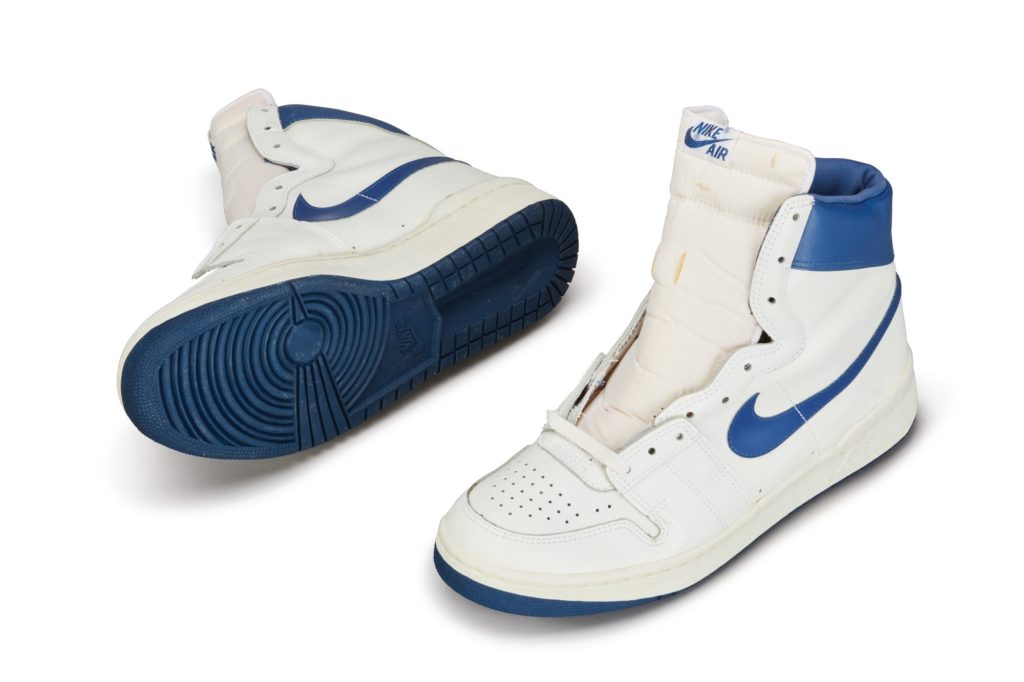
Brad Johnson: Looking at the competitor shoes that have been reintroduced from that era? The Air Ship was probably a far superior shoe at that time; it just wasn’t a big deal.
Jerry Alloco: [Years ago] we’d take models out of DNA and shop them throughout the country through Drew Greer, particularly to get feedback as to what would be a great shoe to bring back. Honestly, the Air Ship never came up because it was never on anybody’s radar screen.
Ron Hill: At that point, basketball was not a street shoe – it was a basketball shoe first, second, and third. But that eventually started to change.
Any sale is a good shoe, and it was a great shoe. It was introduced at a time when basketball shoes weren’t sold on the street, so give it its day.